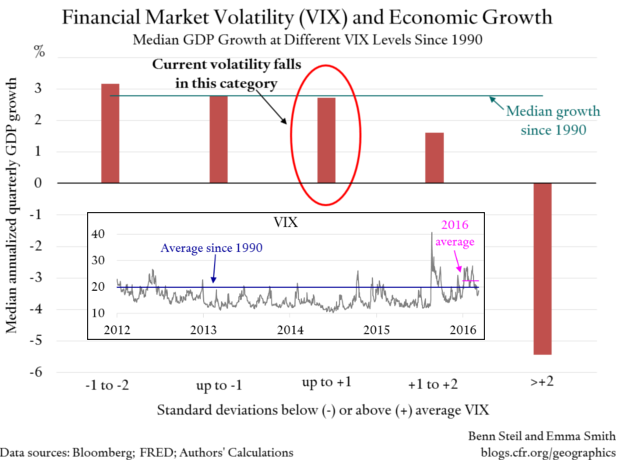
The minutes of the FOMC’s January 26-27 meeting mention financial “market turbulence” five times, and report that members discussed its potential to “restrain U.S. economic activity.” Chair Janet Yellen hinted at similar concerns in her congressional testimony on February 10.
But how worried should they be? To search for clues, we looked at data going back to 1990.
More on:
Market turbulence is proxied by the implied volatility of S&P 500 stock index options, known widely as “VIX.” We find a fairly strong negative relationship between VIX and quarterly economic growth (correlation of -0.44), suggesting that the Fed’s concern may be justified.
But this picture is too broad-brush. VIX readings are, by historical standards, only slightly elevated at present, as shown in the bottom inlaid graphic. VIX has averaged 22 so far this year, which is less than one standard deviation above its long-run average. And the correlation between VIX and growth is a very low (-0.11) at current VIX levels. As the top graphic shows, at current VIX levels annualized quarterly growth has been virtually identical to median growth over the past 26 years (2.7%, as compared to 2.8% on average).
How much would it help if turbulence were to fall to historically low levels? As we can see on the left side of the figure, growth might pick up modestly – the median growth rate is 3.2% in calm markets. And if it were to rise to high levels? Then the Fed should be concerned: as the right side of the figure shows, when VIX is more than two standard deviations above the mean growth plummets into deep recession territory.
Of course, correlation doesn’t mean causality. The relationship can go in the other direction, with indicators of weak growth spooking markets. (Statistically, we find that neither growth nor volatility leads the other by a quarter – the relationship is contemporaneous.) But either way, the Fed should relax – for now. History says that a little turbulence is no threat to growth.
More on:
 Online Store
Online Store